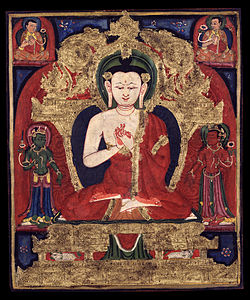Vairochana
| Vairochana | |
 | |
| Redigera Wikidata |

Vairochana är en buddha inom mahayana och vajrayana. Han är i synnerhet viktig för inriktningarna huayan, t'ien-t'ai, shingon och tibetansk buddhism. Han betraktas generellt sett som en personifikation av dharmakaya, och inom vajrayana betraktas han som en av de fem dhyanibuddhorna.[1] Han är den huvudsakliga buddhan i mahayanasutran Avatmasakasutra.[2]
I avatmasakasutra beskrivs Shakyamuni som en manifestation (nirmanakaya) av Vairochana.[1] I samma sutra finns även en historia om en manifestation av Vairochana som en bodhisattva, som till slut blev en buddha. I detta fall kallas han för Rocana, som en sambhogakaya.[2]
Referenser
- ^ [a b] O'Brien, Barbara. ”Vairocana Buddha”. About.com. Arkiverad från originalet den 21 augusti 2016. https://web.archive.org/web/20160821212252/http://buddhism.about.com/od/thetriyaka/a/Vairocana.htm. Läst 20 augusti 2016.
- ^ [a b] Buswell; Lopez (2014) Princeton Dictionary of Buddhism Princeton University Press ISBN 978-0-691-15786-3 uppslagsord: Vairocana.
Externa länkar
- The Enlightenment of Vairocana, Mahāvairocanasūtra översatt till engelska av Alex Wayman och R. Tajima.
- The Meaning of Vairocana in Hua-yen Buddhism av Francis H. Cook.

